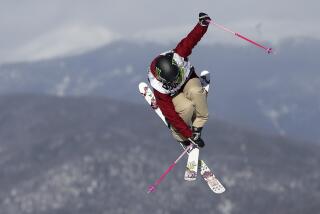Air-Proof Argument
- Share via
It is peaceful in the sky. When he is in the air, skis pointed outward in a V, Alan Alborn could be a bird with ear plugs. The crowd beneath him is roaring, but he hears nothing.
He flies off the 120-meter hill, folds his body forward, and soars. If his form is just right, he lands smoothly and skis to a halt more than 200 meters from takeoff.
Ski jumping is a European sport and Americans have never excelled at it. A soft-spoken, bleached-blond kid who just became old enough to drink aims to change that. And not only show the family he has barely seen for six years the sacrifices were worth it, but bring a smile to the face of the frail, wheelchair-bound old man who discovered him.
Alborn, 21, of Anchorage, has grown up on tour. Once, top competitors ignored him. If recent results are any indication--three top-six World Cup finishes this winter--he must be reckoned with at the 2002 Games. At the least, he is a wild card, someone unpredictable enough to fear.
Is Alborn a medal contender?
“I think I’m pretty close,” he said.
Jumpers usually don’t peak until their late 20s, so Alborn is a pup. But he has been at it a long time. Skiing, flying, and the Alaska wilderness are Alborn’s greatest joys. To get ahead when he combined the first two he had to forfeit most of his sojourns to the latter.
Dave and Mary Alborn thought their kids would be Alpine skiers. They dropped them off at a small slope in Anchorage. Nearby was the Karl Eid Ski Jump Complex, named for the man who was a one-man local proselytizer for the sport.
The jumpers fascinated Alborn. He sneaked over from the ski area and, although his parents tried to discourage him, they eventually gave in. Mary Alborn remembers pausing, though, when presented with a ski jumping release form. She was sure her son was going to break his neck.
Where she envisioned casts, however, Karl Eid saw potential.
“He’s an absolute talent,” Eid said.
Eid, 92, grew up in Germany’s Black Forest region. At the Garmisch-Partenkirchen Winter Olympics of 1936, he worked as a conditioning coach for the German team. He was wounded during World War II and lost a leg. More recently his other leg was amputated because of circulation problems.
Eid, who came to the United States in 1956 and moved to Alaska in 1959, started the Alaska ski jumping program in 1974. Although he doesn’t get out much anymore, he still offers basic instruction to youngsters in his living room.
Alborn is the prize pupil, and Eid will be riveted to his television set during the Salt Lake City Games.
For all of his devotion to ski jumping, what really attracted Alborn to the event was its kinship with flying. His dad is a cargo pilot and Alborn owns a Cessna 185, which he parks on a lake in Anchorage and which he got to fly for only 30 minutes last summer.
“When I first started, people always teased me about ski jumping, that it was the closest thing I could get to flying,” Alborn said. “It was really half true.”
Alborn, who has jumped a U.S. record 210 meters, said that in the air the jumper drinks in the scene in slow motion. He said jumpers get their oomph from their legs and he has improved the speed of orders from the brain to the legs.
“It used to seem like it took 10 seconds,” he said. “Now it’s immediate. You have to be really light and strong and like to fly.”
By the time he passed his 15th birthday, Alborn had progressed beyond what Eid and other local coaches could show him. He moved to Colorado, went to school there for a year and jumped on full-sized hills. After that, Alborn became a ski jumping vagabond, foregoing formal high school, traveling through Europe with demanding U.S. team coach Kari Ylianttila.
He made only cameo visits to Alaska, dashing to the family cabin 100 miles north of Anchorage, rarely seeing his parents, brothers and sisters.
Alborn loves ski jumping, but he feels the absence of some of those things keenly.
“Ever since I started traveling, I feel like I missed out on a lot,” he said. “All of high school. Friends. You trade off things. My only friends my age are ski jumpers.”
One of the things Alborn trades off is body fat. He is 5-feet-11 and wants to weigh 127 or 128. He said he weighs 130. The lighter you are, the farther you fly, so he has been living on chicken, rice and vegetables.
Alborn has quashed his appetite in order to get better. And he is improving steadily. He won his first national title in 1999, on the 120-meter hill, his best Olympic event, and added another last year, when he became the first American to jump more than 200 meters. This winter he had three top-six World Cup finishes in a month. And he won the Gold Cup title in Utah in December to nab an automatic Olympic berth.
“He’ s definitely been making progress every year,” Ylianttila said. “In ski jumping, progress is usually pretty slow. It takes time to learn technique. Younger guys improve much faster. Older, more mature athletes do better. He still needs to get stronger and quicker. The potential is there.”
Ylianttila, a 1980 Finnish Olympian, said Alborn has the chance to raise the profile of his sport in this country, but isn’t predicting a medal this year.
“Maybe not right now,” Ylianttila said. “He could put it all together. It has happened in the past. But there aren’t any surprise winners in ski jumping anymore.”
More to Read
Go beyond the scoreboard
Get the latest on L.A.'s teams in the daily Sports Report newsletter.
You may occasionally receive promotional content from the Los Angeles Times.






